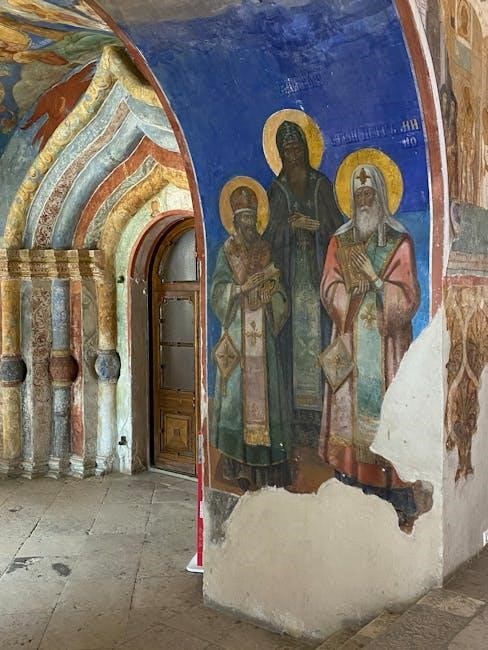The Litany of the Saints is a traditional Catholic prayer seeking divine mercy and saintly intercession, often sung during significant ceremonies and available as a PDF resource.
Definition and Purpose
The Litany of the Saints is a sacred Catholic prayer invoking God’s mercy and the intercession of saints. It is a structured call-and-response chant, often sung, where the faithful ask for divine aid and protection. The purpose of this litany is to seek spiritual guidance, express devotion, and honor the saints, while also imploring God’s forgiveness and grace. It is commonly used in significant ceremonies like the Easter Vigil, ordinations, and consecrations. The litany serves as a powerful tool for communal prayer, fostering unity and faith among the congregation. Its availability in PDF format makes it accessible for personal and liturgical use, preserving its rich tradition and spiritual significance.
Historical Background
The Litany of the Saints traces its origins to the early Christian Church, with roots in ancient processions and prayers for divine intercession. Historically, it was first formally established by Pope Gregory the Great in 590 during a procession to plead for an end to a devastating plague in Rome. Over the centuries, the litany evolved, incorporating invocations of saints and becoming a staple in Catholic liturgical practices. Its structure and use were refined during the Middle Ages, with the Church formalizing its role in major ceremonies such as the Easter Vigil and ordinations. The litany’s historical significance lies in its ability to unite the faithful in prayer, seeking divine mercy and the intercession of saints across generations.
Structure and Format
The Litany of the Saints follows a structured format, beginning with invocations to God, followed by the Blessed Virgin Mary, angels, and various saints. It typically starts with the “Kyrie Eleison” (Lord, have mercy) and progresses through a series of petitions. Each invocation is met with a choral or congregational response, often “Pray for us,” creating a call-and-response rhythm. The litany is divided into sections, including patriarchs, prophets, martyrs, and doctors of the Church. This organized approach ensures a solemn and unified prayer experience. Available in PDF formats, it is easily accessible for congregations to participate in ceremonies like the Easter Vigil, ordinations, and other sacred events.

Key Elements of the Litany of the Saints
The Litany of the Saints includes invocations of saints, a call-and-response format, and congregational participation, emphasizing prayer and intercession, available in structured PDF formats for devotion.
Invocations of Saints
The Litany of the Saints features invocations of various saints, calling upon their intercession. These include Mary, Mother of God, angels, apostles, martyrs, and other holy figures. The structure begins with “Lord, have mercy” and transitions to requests for prayers from the saints. Each invocation is followed by a response, creating a communal rhythm. Specific litanies, like the Litany of St. Joseph, highlight particular saints, while others include broader groups. The Vatican has added new invocations, such as seven for St. Joseph, reflecting evolving devotion. These prayers are often sung or recited, emphasizing the unity of the faithful with the saints in heaven.
Call-and-Response Format
The Litany of the Saints follows a call-and-response format, fostering active participation from the congregation. Typically, a cantor or leader recites the invocations, while the assembly responds with phrases like “pray for us” or “Lord, have mercy.” This rhythmic exchange creates a sense of unity and communal prayer. The structure often begins with appeals to God, followed by requests for intercession from the Blessed Virgin Mary, angels, and various saints. The call-and-response pattern is simple yet profound, enabling even large groups to engage devotionally. This format is particularly evident in ceremonies like the Easter Vigil and ordinations, where the litany is sung or recited with solemnity.
Role of the Congregation
The congregation plays a vital role in the Litany of the Saints, actively participating through prescribed responses. These responses, such as “pray for us” or “Lord, have mercy,” are integral to the prayer’s structure and foster a sense of communal devotion. The congregation’s involvement not only enhances the liturgical experience but also strengthens the collective plea for divine mercy and intercession. This participation is particularly significant in ceremonies like the Easter Vigil, where the litany serves as a unifying element among worshipers. By engaging in the call-and-response format, the congregation embodies the Church’s tradition of shared prayer and spiritual solidarity, reinforcing the litany’s purpose as a communal supplication to God and the saints.
Historical Significance
The Litany of the Saints traces its origins to ancient Catholic processions, such as those led by Gregory the Great in 590 to combat a plague, emphasizing communal prayer and divine intercession.
Origins in the Catholic Church
The Litany of the Saints originates in the early Catholic Church, evolving from processional prayers like those led by Pope Gregory the Great in 590 to supplicate for divine aid during a devastating epidemic in Rome. These processions, known as litaniae maiores, were solemn rituals that involved the entire community, reflecting the Church’s reliance on collective prayer for deliverance. Over centuries, this practice transformed into the structured litany format, incorporating invocations of saints and a call-and-response rhythm, becoming integral to major ceremonies and devotional life. The Vatican’s continued use of the litany, as seen in modern PDF resources, underscores its enduring significance in Catholic tradition.
Use in Major Ceremonies
The Litany of the Saints holds a prominent role in significant Catholic ceremonies, such as the Easter Vigil, ordinations, and consecrations of churches or altars. During these events, the litany is often sung, creating a solemn and devotional atmosphere. For instance, before the conclave to elect a new pope, cardinals chant the litany in the Vatican’s Apostolic Palace, seeking divine guidance. Similarly, in the Easter Vigil, the litany serves as a prayer of intercession, invoking the saints to join in the celebration of Christ’s resurrection. The structured call-and-response format engages the congregation, fostering unity and spiritual connection. This tradition underscores the litany’s enduring importance in Catholic worship and its ability to enrich major liturgical events with deep spiritual meaning.
Evolution Over the Centuries
The Litany of the Saints has undergone significant evolution since its origins in the early Catholic Church. Initially used in processions during crises, such as the plague in Rome under Gregory the Great, it gradually became a structured prayer in liturgical ceremonies. Over the centuries, new invocations were added, reflecting the veneration of saints and the needs of the faithful. For example, the Litany of St. Joseph was expanded in recent years to include seven new invocations. This adaptability ensures the litany remains relevant while preserving its core purpose of seeking divine mercy and saintly intercession. Its enduring presence in major ceremonies highlights its spiritual significance across generations.
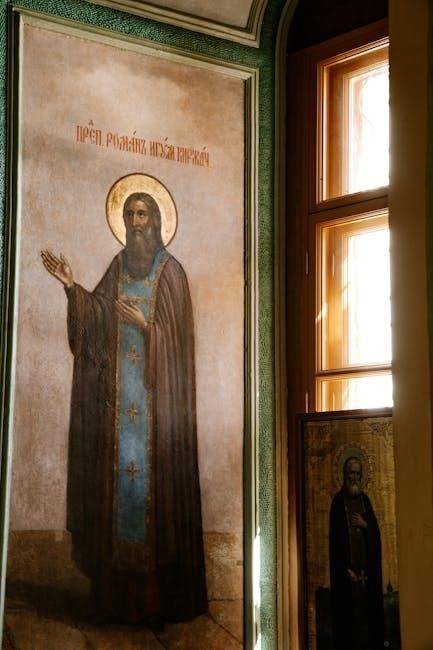
Modern Applications
The Litany of the Saints is integral to modern Catholic rites, used in Easter Vigil, ordinations, and consecrations. It is also accessible as a downloadable PDF resource for devotion.
Use in Easter Vigil
The Litany of the Saints holds a prominent place in the Easter Vigil, a solemn yet joyful ceremony marking the resurrection of Christ. It is sung as part of the liturgical rites, invoking the intercession of saints and seeking divine mercy. The litany serves as a bridge between the somberness of Lent and the jubilation of Easter, reminding the faithful of the communion of saints. Its inclusion in the Easter Vigil underscores its role in major Catholic ceremonies. Additionally, the availability of the Litany of the Saints as a downloadable PDF resource ensures its accessibility for modern congregations, aiding in devotion and participation during this sacred time.
Role in Ordinations and Consecrations
The Litany of the Saints plays a vital role in Catholic ordinations and consecrations, serving as a prayerful invocation for divine grace and guidance. It is traditionally sung at the beginning of these sacred ceremonies, calling upon the intercession of saints to assist in the solemn act of dedicating individuals or places to God’s service. During ordinations, the litany seeks blessings for the candidates, while in consecrations, it petitions for the sanctification of churches or altars. The litany’s call-and-response format fosters a sense of communal prayer, uniting the congregation in supplication. Its inclusion in official PDF resources ensures its proper use in these rites, maintaining the rich traditions of the Catholic Church.
Digital Availability (e.g., PDF)
The Litany of the Saints is widely accessible in digital formats, particularly as PDF documents, facilitating its use in modern religious practices. These PDF resources are often provided by Catholic dioceses and religious organizations, ensuring faithful adherence to traditional texts. They include structured versions for specific occasions, such as the Easter Vigil or ordinations, making them invaluable for both personal devotion and communal worship. The digital availability of the litany not only preserves its historical integrity but also enhances its reach, allowing believers worldwide to engage with this timeless prayer. This convenient format reflects the Church’s commitment to blending tradition with contemporary technology to support spiritual life.
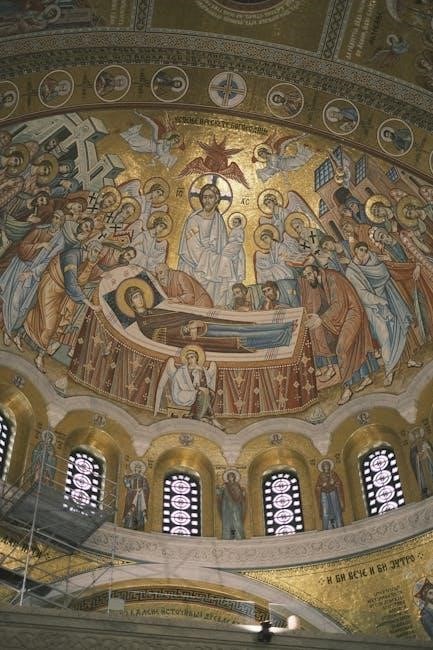
Notable Examples and Variations
The Litany of St. Joseph and Jesuit Saints are notable examples, alongside a comprehensive PDF listing over 100 saints and personalized versions for individual devotion.
Litany of St. Joseph
The Litany of St. Joseph is a devotional prayer honoring the spouse of the Virgin Mary, seeking his intercession. It is structured with invocations, beginning with “Lord, have mercy” and “Christ, have mercy,” followed by appeals to St. Joseph as a “just man” and “terror of demons.” In 2021, the Vatican added seven new invocations, reflecting his role as a model of faith and service. This litany is often recited during St. Joseph’s feast day on March 19 and is included in the Litany of the Saints PDF, making it accessible for personal and communal devotion. Its rhythmic format fosters participation, deepening reverence for St. Joseph’s virtues;
Litany of Jesuit Saints
The Litany of Jesuit Saints honors the blessed and canonized members of the Society of Jesus, invoking their intercession. It includes saints like Ignatius of Loyola, founder of the Jesuits, and Aloysius Gonzaga, known for his piety. The litany also recognizes figures such as Robert Bellarmine and John Berchmans, highlighting their contributions to the Church. This specific litany is often used within Jesuit communities and by devotees worldwide. It is included in the Litany of the Saints PDF, offering a structured prayer format that reflects Jesuit spirituality. By reciting this litany, believers connect with the order’s rich tradition of faith, service, and devotion.
Personalized Litanies
Personalized litanies allow individuals or communities to create tailored prayers, incorporating specific saints or intentions. They often reflect personal devotion, local traditions, or particular needs. The Litany of the Saints PDF can be adapted to include local patrons or personal favorites, making the prayer more relatable. For instance, a parish might add their patron saint, while an individual might include saints who inspire them. This customization enriches the prayer experience, fostering deeper connection and meaning. Personalized litanies are commonly used in private devotion, community gatherings, or special events, blending tradition with individuality. They remain faithful to the litany’s structure while offering flexibility for unique expressions of faith.

Cultural and Devotional Impact
The Litany of the Saints deeply influences Catholic devotion, fostering intercessory prayer and connecting believers to rich Church traditions, while its PDF availability enhances modern accessibility.
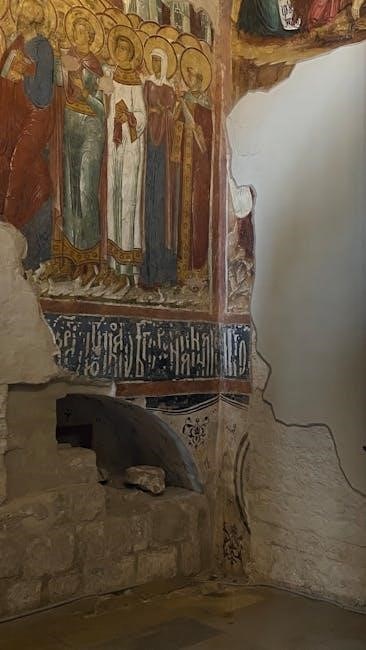
Role in Catholic Devotion
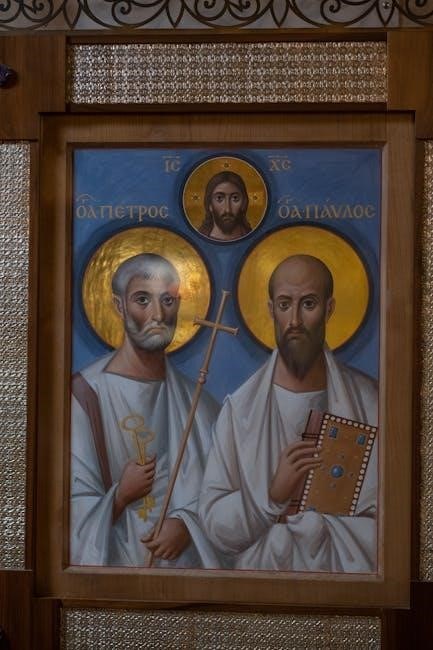
The Litany of the Saints holds a profound role in Catholic devotion, serving as a powerful form of intercessory prayer. It invites the faithful to seek the saints’ intervention, fostering a deep connection to the communion of saints. The litany’s call-and-response format encourages active participation, creating a sense of unity among worshippers. Its use in major ceremonies, such as the Easter Vigil and ordinations, underscores its significance in spiritual life. Additionally, the availability of the litany in PDF formats has made it more accessible for personal and communal devotion, allowing believers to engage with this ancient prayer in modern times. This tradition enriches Catholic spirituality, bridging heaven and earth through prayer.
Use in Intercessory Prayer
The Litany of the Saints is a cornerstone of intercessory prayer, invoking the saints’ aid for divine mercy and protection. Its structured format, with petitions like “Pray for us,” encourages believers to seek intercession. The litany’s call-and-response nature fosters communal prayer, uniting the faithful in supplication. Available in PDF, it’s easily accessible for personal and group devotion. For instance, the Litany of St. Joseph was updated with new invocations, reflecting its evolving role. This prayer tool strengthens faith and provides comfort, emphasizing the Church’s belief in the saints’ ongoing intercession. Its use in ceremonies like the Easter Vigil highlights its significance in seeking spiritual guidance and grace.

Connection to Church Traditions
The Litany of the Saints is deeply rooted in Catholic Church traditions, serving as a bridge between the faithful and the divine. Its use in major ceremonies, such as the Easter Vigil and papal conclaves, underscores its historical significance. The litany’s structured format, with invocations of saints and the Kyrie Eleison, reflects ancient liturgical practices. The Vatican’s updates, like adding invocations to the Litany of St. Joseph, demonstrate its evolving yet enduring role in Church life. Available in PDF, it remains a vital tool for devotion, connecting modern believers to centuries-old traditions. This prayer emphasizes the communion of saints, linking the Church militant with the Church triumphant in a shared act of worship and intercession.
The Litany of the Saints remains a timeless prayer, bridging heaven and earth through devotion and intercession. Its enduring relevance and digital availability ensure its continued presence in Catholic traditions.
The Litany of the Saints is a sacred prayer invoking divine mercy and saintly intercession, deeply rooted in Catholic tradition. Originating from early Church processions, it has evolved into a structured call-and-response format, sung in major ceremonies like the Easter Vigil and ordinations. The litany includes invocations of the Virgin Mary, angels, and various saints, emphasizing communal prayer and devotion. Its historical significance is marked by its use in times of crisis, such as the plague in Rome under Pope Gregory the Great. Modern adaptations, like the Litany of St. Joseph, highlight its flexibility. Today, it remains a vital part of Catholic worship, available in digital formats like PDF, ensuring its accessibility and enduring relevance in spiritual practices.

Final Thoughts on the Litany’s Importance
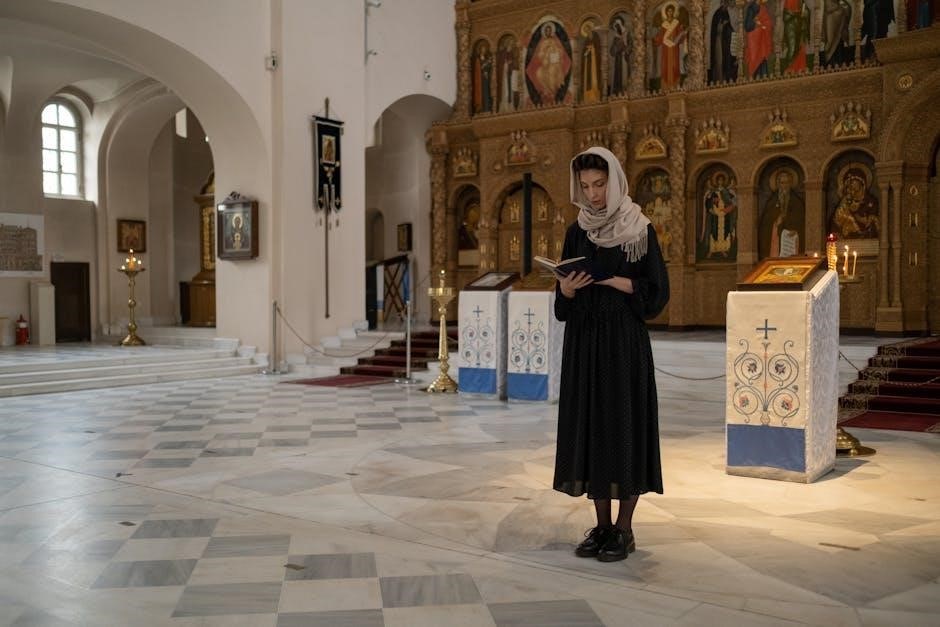
The Litany of the Saints holds profound significance as a bridge between heaven and earth, uniting believers with the divine and the communion of saints. Its call-and-response format fosters a sense of unity and shared devotion among the faithful. Historically, it has served as a powerful tool for intercession, particularly in times of crisis, such as the plague in 6th-century Rome. The inclusion of various saints reflects the richness of Catholic tradition and the universal call to holiness. In modern times, its availability in formats like PDF ensures its accessibility, enabling continued use in Easter Vigils, ordinations, and personal devotion. This litany remains a vibrant expression of faith, connecting past and present in prayer and devotion.
